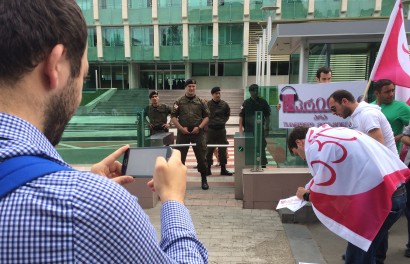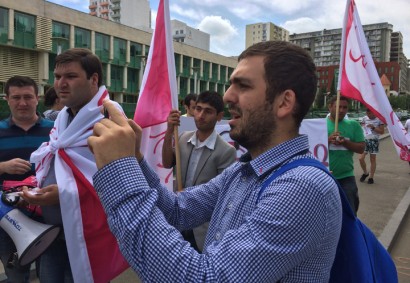TBILISI, Georgia, 30 May 2014 A reporter for Media House Palitra uses a cell phone to video a demonstration by members an NGO devoted to the protection of human rights. The protestors alleged that employees of Georgias Interior Ministry routinely conduct secret surveillance on perceived political opponents, activists and common Georgian citizens. The Interior Ministry, and some of its uniformed employees, are seen in the background.
This young reporter uses his cell phone to video the event. Minutes later, he called the story in to his desk at the Media House Palitra headquarters, before heading back to the office where he wrote narration and oversaw the editing of his video story for the Internet.
I was surprised to see journalists using cell phones as primary reporting tools something that many US media organizations have yet to figure out. As this young reporter and some of his colleagues pointed out, they dont need to carry around big, heavy, intrusive, expensive camera gear to do their job. Nor do they have the means to purchase that kind of gear.
Having said that, I spent quite a bit of my two-week visit to Georgia instructing on how to make visual stories more powerful. Georgians take great pride in the fact that their alphabet is one of only 14 alphabets on the planet. But I introduced them to a 15th alphabet the visual alphabet and demonstrated how to speak the visual language more effectively. I covered the alphabet, the Clip-to-Story progression and the Six-Shot System. We screened a number of the videos that I routinely use during my Backpack Journalism Workshops.
I spent my last two days in Georgia at the Media House Palitra, a family owned business that includes hard copy and web newspapers, magazines and books, television and radio. It was really exciting to see this journalistic endeavor succeed.
I was in Georgia at the invitation of the U.S. Embassy in Tbilisi to give a series of workshops, presentations and discussions with professional journalists, journalism students and the general public interested in raising their voices with powerful visual storytelling. The idea is that a free press and free exchange of information are essential components of any free, democratic society.
Its a tense time in Georgia, which borders Russia to the north. With violence rising in nearby Ukraine, many Georgians are deeply concerned about their countrys stability. And many of them recognize and understand the need for the free exchange of unbiased information. And thats exactly what these new tools and the Internet allow all of us to do: To participate in the international dialogue that we call journalism. To raise our voices. To make videos that rock.
And by the way, I used my own iPhone 5S to make these pictures.
(Photos by Bill Gentile)


